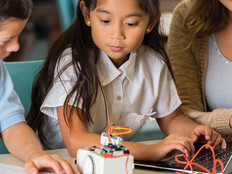Overcoming Obstacles in Teaching Computer Science
Infrastructure is not a major issue to bring computer science to schools, according to Eugene Lemon, president of the Golden Gate chapter of the Computer Science Teachers Association.
“To me, the bigger issue is the lack of trained staff, of teachers, to teach computer science concepts,” he says.
Lemon’s is a common refrain. While some states like Rhode Island are providing access to necessary training, districts elsewhere may be on their own.
In Broward County, Fla., district officials began building a partnership with the nonprofit Code.org in 2013, participating in events like the Hour of Code and Computer Science Education Week. “From that partnership, we had some great opportunities to provide training and curriculum to teachers,” says Christine Semisch, an IT director within the district. Soon, Semisch says, Broward County will have about 1,000 teachers trained in computer science instruction.
In Delaware, state officials recognized the difficulty of training staff and have made an online computer science course available to students. Delaware is also paying for teachers to coach kids through the class. As a result, the state has bumped the number of kids participating in AP computer science to nearly 170.
“Those don’t sound like huge numbers, but we had only 25 kids participating in these classes before,” says Michael Watson, chief academic officer for the state. “We now have more kids passing than were even taking the test just a few years ago. So we’re pretty excited about that.”
School districts also frequently find it challenging to promote diversity in computer science classes. As with the tech industry, programming classes tend to skew disproportionately white and male, and schools are looking for ways to encourage girls and students of color to sign up.
In Broward County’s most advanced AP computer science class, only 23 percent of the students are female. But in the district’s introductory course, 40 percent of students are girls. Lisa Milenkovic, supervisor of STEM and computer science for the district, hopes that the intro course will help create a pipeline that eventually results in more diverse advanced classes.
“I remember having this issue in chemistry,” Milenkovic says. “I was the only girl in chemistry, and now, there are more girls than boys taking chemistry. Hopefully, then, the numbers will start shifting in the workforce.”







